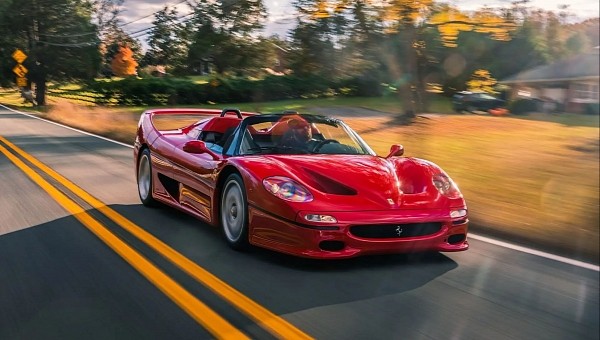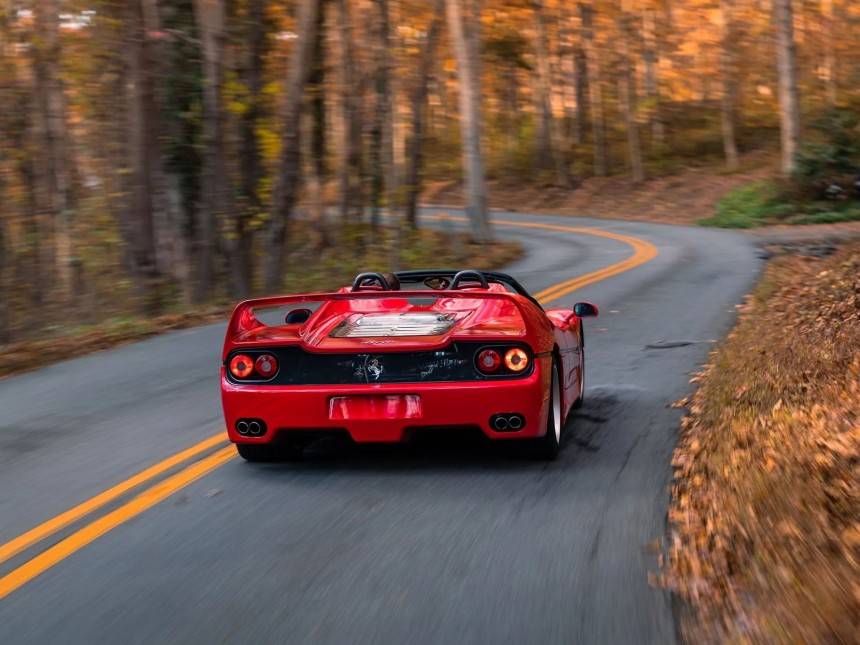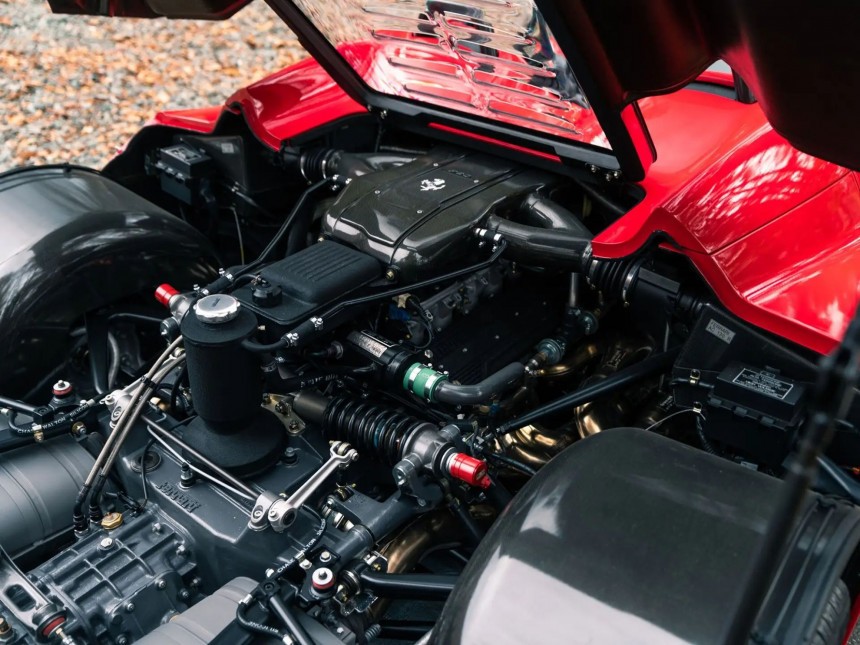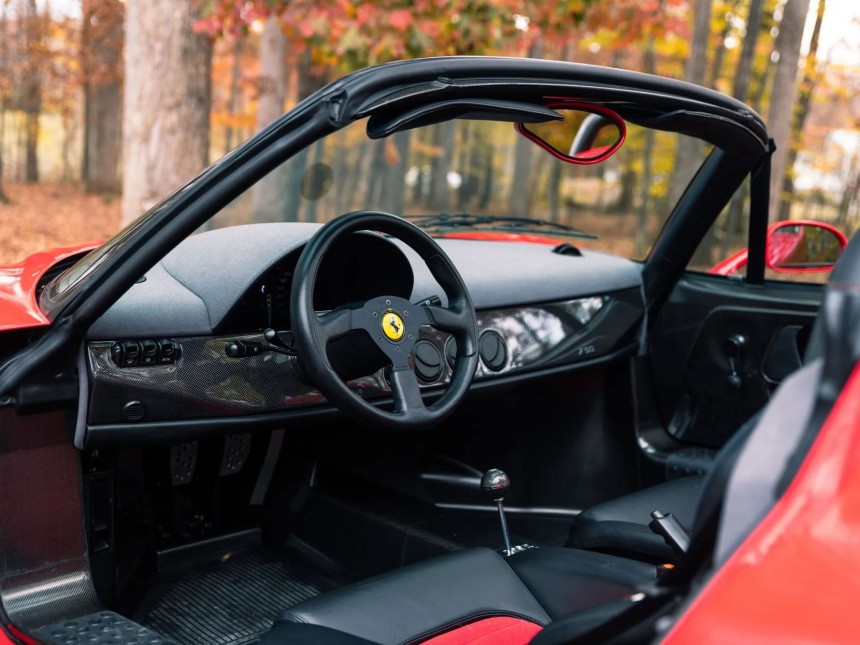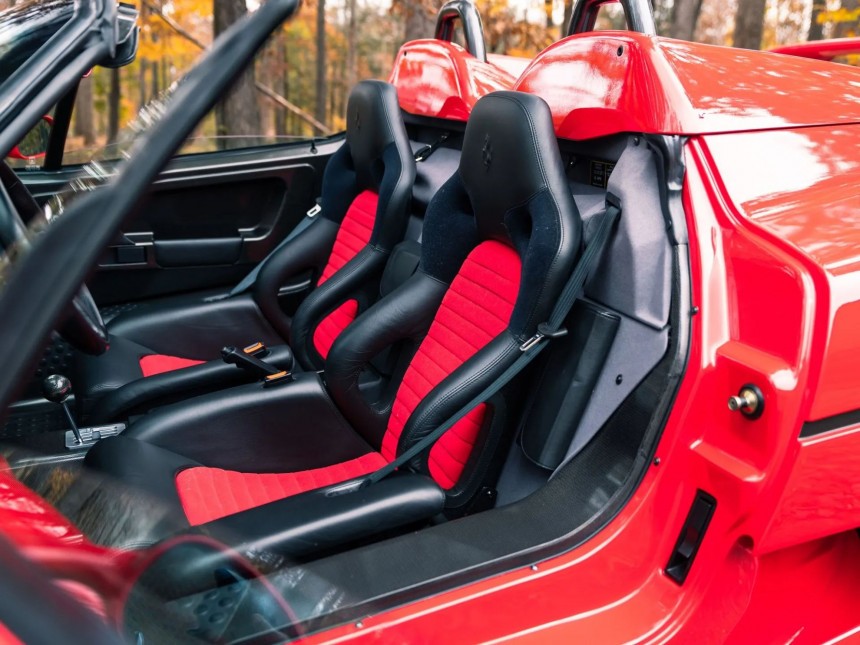In 1987, Ferrari released the F40 to mark its 40th anniversary, and the public loved it. That motivated the Prancing Horse to create an even superior model to commemorate its 50th anniversary. And boy, they made one hell of a machine: the Ferrari F50.
The Italian marque spent four years developing the road-going car, taking inspiration from its racing technologies. But the first thing you’ll notice about the car is its stunning curvy bodywork. Auto design back in the 1980s typically involved lots of wedges – instead, the designers at Pininfarina opted for free-flowing lines that hint toward Maranello’s legendary sports racers of the 1950s and 1960s. Moreover, the coachwork was molded from carbon fiber, Kevlar, and Nomex honeycomb.
Instead of drawing inspiration from rallying, as it did for the F40, Ferrari used its expertise in Formula 1 to create the complex machine. At the core of the F50 stood a naturally aspirated 4.7-liter V12 engine, mounted in a mid-rear architecture to ensure the optimal weight distribution. The engine has an interesting story – it begins in Ferrari’s 1992 Formula 1 car, then continues in the 4-liter 333 SP sports car, helping it win many driver’s and constructor’s championships in IMSA GT and FIA sports car racing between 1995 and 2001.
Of course, the engine had to be tuned for optimum road use – in the F50, the new high-compression V12 outputted 513 hp (383 kW or 502 ps) and 465 Nm (343 lb-ft) of torque. It was enough to make the vehicle capable of reaching a top speed of 202 mph (325 kph) in just under 3.6 seconds.
In a first for the brand, Ferrari equipped the road car with a tub made entirely out of carbon fiber. The engine was bolted directly into the tub via metal subframes. How does this detail affect the car’s performance? Well, it’s helped achieve superior weight reduction and rigidity, although for a cost – all the vibration is transferred directly into the cabin.
So, the stripped-out F50 wasn’t meant for the casual Ferrari customer who wanted a chill weekend ride around their hometown, but rather for someone who fancied pushing the car to its limits – it basically invited you to floor it, especially once you hear the roaring V12 engine.
No one would dare drive this beast without the appropriate braking power. Ferrari fitted it with massive Brembo brakes with huge rotors, 14 inches in front and 13.2 inches at the rear.
Some people criticized Ferrari for building too many F40s because it diluted its rarity and valuation: 1,311 units were produced. That’s why the F50 was built in small numbers, with only 349 examples. It remains a highly collectible piece of Ferrari’s history, especially since it’s a component of the “Big Five” hypercar portfolio, highly sought-after by the most dedicated Maranello enthusiasts. Moreover, the F50 is the second rarest of the five Ferrari halo cars, surpassed only by the 288 GTO, which was produced in only 272 units.
But it took the F50 some years to become a hot commodity in the collector space – the main reason for its initial undesirability was the perceived failure of continuing the legacy of the F40, the last car developed under the oversight of Enzo Ferrari. The F50 was seen as a beefed-up version of the F40, and some considered it too harsh. However, time has been kind to the F50, and its value skyrocketed into the seven-figure range as collectors realized how undervalued it was.
The 1995 Ferrari I’d like to present today was the 36th F50 built, chassis number 03501. Amazingly, it’s had a single owner for 27 years, an enthusiast from Hong Kong. The invoices on file show the car was driven sparingly and serviced occasionally at a local show.
In 2020, the F50 received full certification from Ferrari Classiche and was issued a Red Book – basically, Ferrari validated that its components match the original spec from when it first rolled off the production line.
In May last year, the renowned marque specialist DK Engineering in the UK performed a comprehensive restoration, bringing each component to optimal condition. For instance, the suspension, radiator, and steering rack were removed and refinished, the wheels refurbished, and the interior retrimmed. All the work done on the machine amounted to £62,000 ($74,882).
It’s hard to come by such an immaculate F50, and the fact that it’s also going for sale is a rare and fantastic opportunity. Not only was the car barely driven, but all the recent servicing restored it to its former glory. The odometer currently reads just 1,342 kilometers (834 miles) – it’s safe to say that the car will probably end up in another collection and won’t spend too much time on the road.
As you’d expect, the future owner will have to spend a fortune on the vehicle – the auction listing recommends a price between $4.75M and $6M (€4.45M and €5.5M). Included is a soft top in the proper canvas bag, the factory-issued flight case for the hard top, two pieces of Schedoni fitted luggage, owner’s manuals, a photo build album, and tools.
Instead of drawing inspiration from rallying, as it did for the F40, Ferrari used its expertise in Formula 1 to create the complex machine. At the core of the F50 stood a naturally aspirated 4.7-liter V12 engine, mounted in a mid-rear architecture to ensure the optimal weight distribution. The engine has an interesting story – it begins in Ferrari’s 1992 Formula 1 car, then continues in the 4-liter 333 SP sports car, helping it win many driver’s and constructor’s championships in IMSA GT and FIA sports car racing between 1995 and 2001.
Of course, the engine had to be tuned for optimum road use – in the F50, the new high-compression V12 outputted 513 hp (383 kW or 502 ps) and 465 Nm (343 lb-ft) of torque. It was enough to make the vehicle capable of reaching a top speed of 202 mph (325 kph) in just under 3.6 seconds.
So, the stripped-out F50 wasn’t meant for the casual Ferrari customer who wanted a chill weekend ride around their hometown, but rather for someone who fancied pushing the car to its limits – it basically invited you to floor it, especially once you hear the roaring V12 engine.
No one would dare drive this beast without the appropriate braking power. Ferrari fitted it with massive Brembo brakes with huge rotors, 14 inches in front and 13.2 inches at the rear.
But it took the F50 some years to become a hot commodity in the collector space – the main reason for its initial undesirability was the perceived failure of continuing the legacy of the F40, the last car developed under the oversight of Enzo Ferrari. The F50 was seen as a beefed-up version of the F40, and some considered it too harsh. However, time has been kind to the F50, and its value skyrocketed into the seven-figure range as collectors realized how undervalued it was.
The 1995 Ferrari I’d like to present today was the 36th F50 built, chassis number 03501. Amazingly, it’s had a single owner for 27 years, an enthusiast from Hong Kong. The invoices on file show the car was driven sparingly and serviced occasionally at a local show.
In May last year, the renowned marque specialist DK Engineering in the UK performed a comprehensive restoration, bringing each component to optimal condition. For instance, the suspension, radiator, and steering rack were removed and refinished, the wheels refurbished, and the interior retrimmed. All the work done on the machine amounted to £62,000 ($74,882).
It’s hard to come by such an immaculate F50, and the fact that it’s also going for sale is a rare and fantastic opportunity. Not only was the car barely driven, but all the recent servicing restored it to its former glory. The odometer currently reads just 1,342 kilometers (834 miles) – it’s safe to say that the car will probably end up in another collection and won’t spend too much time on the road.
